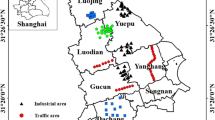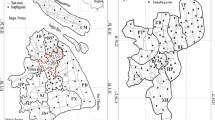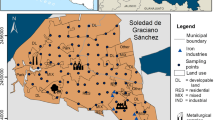Abstract
Purpose
Changes in the magnetic phase, magnetic concentration, and/or magnetic grain-sized of dust-bound iron-bearing minerals depend on both lithogenic components and anthropogenic inputs. Knowledge of the magnetic properties of road dusts in various road ecosystems is of paramount importance to control dust pollution for the benefit of the environment and human health.
Methods
The magnetic characteristics of road dusts, collected in the coastal areas of southern Fujian, China, were determined via magnetic measurements, X-ray diffraction analysis, Mössbauer spectroscopy (MS), and scanning electron microscopy with integrated energy-dispersive X-ray spectrometry.
Results
Analyses of the temperature dependence of magnetization, backfield demagnetization, and hysteresis loops suggested that the main magnetic carriers in road dusts were low-coercivity minerals with minimal antiferromagnetic phases derived from anthropognic sources. The coefficients of variation for χLF, SIRM, and χARM were 53.46%, 50.98%, and 58.56%, respectively. Samples with high values of χLF had a high ratio of iron ions in the octahedral B and tetrahedral A sites in magnetite. The most common iron oxides in the dust-bound iron-bearing minerals were non-stoichiometric magnetite, hematite, and possibly metallic iron. Elevated concentrations of trace metals (e.g., Cd, Cr, Co, and V) in the dust-bound iron-bearing minerals partially confirmed the coexistence of magnetic minerals and trace metals in the road dusts.
Conclusions
Analysis of the spatial characteristics of magnetic concentration–related parameters will be useful in accurately documenting and tracking levels of pollution.





Similar content being viewed by others
References
Bourliva A, Papadopoulou L, Aidona E (2016) Study of road dust magnetic phases as the main carrier of potentially harmful trace elements. Sci Total Environ 553:380–391
Bourliva A, Kantiranis N, Papadopoulou L, Aidona E, Christophoridis C, Kollias P, Evgenakis M, Fytianos K (2018) Seasonal and spatial variations of magnetic susceptibility and potentially toxic elements (PTEs) in road dusts of Thessaloniki city, Greece: a one-year monitoring period. Sci Total Environ 639:417–427
Bucko MS, Magiera T, Johanson B, Petrovsky E, Pesonen LJ (2011) Identification of magnetic particulates in road dust accumulated on roadside snow using magnetic, geochemical and micro-morphological analyses. Environ Pollut 159:1266–1276
Day R, Fuller M, Schmidt VA (1977) Hysteresis properties of titanomagnetites: grain size and composition dependence. Phys Earth Planet Inter 13:260–267
Dearing JA (1999) Environmental magnetic sussecptibility: using the Bartington MS2 system. Chi Publishing, England
Dunlop, DJ (2002) Theory and application of the Day plot (Mrs/Ms versus Hcr/Hc) 1. Theoretical curves and tests using titanomagnetite data. J Geophys Res: Solid Earth 107: 2056. https://doi.org/10.1029/2001JB000486.
Dytłow S, Winkler A, Górka-Kostrubiec B, Sagnotti L (2019) Magnetic, geochemical and granulometric properties of street dust from Warsaw (Poland). J Appl Geophys 169:58–73
Górka-Kostrubiec B, Werner T, Dytłow S, Szczepaniak-Wnuk I, Jeleńska M, Hanc-Kuczkowska A (2019) Detection of metallic iron in urban dust by using high-temperature measurements supplemented with microscopic observations and Mössbauer spectra. J Appl Geophys 166:89–102
Guo X, Banerjee SK, Wang R, Zhao G, Song H, Lü B, Li Q, Liu X (2018) Why magnetite is not the only indicator of past rainfall in the Chinese Loess Plateau? Geophys J Int 213:2128–2137
Hou S, Zheng N, Tang L, Ji X, Li Y, Hua X (2019) Pollution characteristics, sources, and health risk assessment of human exposure to Cu, Zn, Cd and Pb pollution in urban street dust across China between 2009 and 2018. Environ Int 128:430–437
Jilbert T, Asmala E, Schröder C, Tiihonen R, Myllykangas J, Virtasalo JJ, Kotilainen A, Peltola P, Ekholm P, Hietanen S (2018) Impacts of flocculation on the distribution and diagenesis of iron in boreal estuarine sediments. Biogeosciences 15:1243–1271
Kim W, Doh SJ, Yu Y (2009) Anthropogenic contribution of magnetic particulates in urban roadside dust. Atmos Environ 43:3137–3144
King JW, Banerjee SK, Marvin J (1983) A new rock-magnetic approach to selecting sediments for geomagnetic paleointensity studies: application to paleointensity for the last 4000 years. J Geophy Res-Sol Ea 88:5911–5921
Klencsár Z, Kuzmann E, Vértes A (1996) User-friendly software for Mössbauer spectrum analysis. J Radioanal Nucl Chem 210:105–118
Li H, Qian X, Wei H, Zhang R, Yang Y, Liu Z, Hu W, Gao H, Wang Y (2014) Magnetic properties as proxies for the evaluation of heavy metal contamination in urban street dusts of Nanjing, Southeast China. Geophys J Int 199:1354–1366
Liu ZF, Ma JL, Wei GJ, Liu QS, Jiang ZX, Ding X, Peng SS, Zeng T, Ouyang TP (2017) Magnetism of a red soil core derived from basalt, northern Hainan Island, China: volcanic ash versus pedogenesis. J Geophys Res-Sol Ea 122:1677–1696
Liu H, Yan Y, Chang H, Chen H, Liang L, Liu X, Qiang X, Sun Y (2019) Magnetic signatures of natural and anthropogenic sources of urban dust aerosol. Atmos Chem Phys 19:731–745
Lu SG, Chen DJ, Wang SY, Liu YD (2012) Rock magnetism investigation of highly magnetic soil developed on calcareous rock in Yun-Gui Plateau, China: evidence for pedogenic magnetic minerals. J Appl Geophys 77:39–50
Luo XS, Ding J, Xu B, Wang Y, Li H, Yu S (2012) Incorporating bioaccessibility into human health risk assessments of heavy metals in urban park soils. Sci Total Environ 424:88–96
Magiera T, Jabłońska M, Strzyszcz Z, Rachwał M (2011) Morphological and mineralogical forms of technogenic magnetic particles in industrial dusts. Atmos Environ 45:281–290
Ram SS, Kumar RV, Chaudhuri P, Chanda S, Santra SC, Sudarshan M, Chakraborty A (2014) Physico-chemical characterization of street dust and re-suspended dust on plant canopies: an approach for finger printing the urban environment. Ecol Indic 36:334–338
Rivas J, Ortega B, Sedov S, Solleiro E, Sychera S (2006) Rock magnetism and pedogenetic processes in Luvisol profiles: examples from Central Russia and Central Mexico. Quatern Int 156–157:212–223
Sun J, Yu R, Hu G, Su G, Zhang Y (2018) Tracing of heavy metal sources and mobility in a soil depth profile via isotopic variation of Pb and Sr. Catena 171:440–449
Szumiata T, Gawroński M, Górka B, Brzózka K, Świetlik R, Trojanowska M, Strzelecka M (2013) Chemical, magnetic and Mössbauer effect analysis of road dust from expressway. Nukleonika 58:109–112
Szumiata T, Rachwał M, Magiera T, Brzózka K, Gzik-Szumiata M, Gawroński M, Górka B, Kyzioł-Komosińska J (2017) Iron-containing phases in metallurgical and coke dusts as well as in bog iron ore. Nukleonika 62:187–195
Szuszkiewicz M, Magiera T, Kapička A, Petrovský E, Griso H, Gołuchowska B (2015) Magnetic characteristics of industrial dust from different sources of emission: a case study of Poland. J Appl Geophys 116:84–92
Tan Z, Lu S, Zhao H, Kai X, Jiaxian P, Win MS, Yu S, Yonemochi S, Wang Q (2018) Magnetic, geochemical characterization and health risk assessment of road dust in Xuanwei and Fuyuan, China. Environ Geochem Hlth 40:1541–1555
Valdespino OEM, Alvarez VC (1997) Paleomagnetic and rock magnetic evidence for inverse zoning in the Parguaza batholith (southwestern Venezuela) and its implications about tectonics of the Guyana shield. Precambrian Res 85:1–25
Vandenberghe RE, Barrero CA, Costa GM, Van San E, De Grave E (2000) Mössbauer characterization of iron oxides and (oxy)hydroxides: the present state of the art. Hyperfine Interact 126:247–259
Verma HC, Tripathi RP (2000) Characterization of iron-bearing minerals in Giril lignite from Rajasthan and study of their decomposition during combustion using 57Fe Mössbauer spectroscopy. Fuel 79:599–606
Wang G, Chen J, Zhang W, Chen Y, Ren F, Fang A, Ma L (2019a) Relationship between magnetic properties and heavy metal contamination of street dust samples from Shanghai, China. Environ Sci Pollut Res Int 26:8958–8970
Wang G, Chen J, Zhang W, Ren F, Chen Y, Fang A, Ma L (2019b) Magnetic properties of street dust in Shanghai. China and its relationship to anthropogenic activities. Environ Pollut 255:113214. https://doi.org/10.1016/j.envpol.2019.113214
Wang G, Oldfield F, Xia D, Chen F, Liu X, Zhang W (2012) Magnetic properties and correlation with heavy metals in urban street dust: a case study from the city of Lanzhou, China. Atmos Environ 46:289–298
Wang S, Hu G, Yan Y, Wang S, Yu R, Cui J (2019c) Source apportionment of metal elements in PM2.5 in a coastal city in Southeast China: combined Pb-Sr-Nd isotopes with PMF method. Atmos Environ 198:302–312
Wang X (2013) Mineralogical and chemical composition of magnetic fly ash fraction. Environ Earth Sci 71:1673–1681
Wang X (2016) Investigation of the pollution in the street dust at Xuzhou, China, using magnetic, micro-morphological and Mössbauer spectra analyses. Environ. Earth Sci 75:899
Warrier AK, Shankar R, Manjunatha BR, Harshavardhana BG (2014) Mineral magnetism of atmospheric dust over southwest coast of India: impact of anthropogenic activities and implications to public health. J Appl Geophys 102:1–9
Xu L, Yu Y, Yu J, Chen J, Niu Z, Yin L, Zhang F, Liao X, Chen Y (2013) Spatial distribution and sources identification of elements in PM2.5 among the coastal city group in the Western Taiwan Strait region, China. Sci Total Environ 442:77–85
Yang T, Liu Q, Li H, Zeng Q, Chan L (2010) Anthropogenic magnetic particles and heavy metals in the road dust: magnetic identification and its implications. Atmos Environ 44:1175–1185
Yang T, Zeng Q, Liu Z, Liu Q (2011) Magnetic properties of the road dusts from two parks in Wuhan city, China: implications for mapping urban environment. Environ Monit Assess 177:637–648
Zhang C, Qiao Q, Appel E, Huang B (2012) Discriminating sources of anthropogenic heavy metals in urban street dusts using magnetic and chemical methods. J Geochem Explor 119-120:60–75
Zheng Y, Zhang S (2008) Magnetic properties of street dust and topsoil in Beijing and its environmental implications. Chinese Science Bulletin 53:408–417
Zhu Z, Li Z, Bi X, Han Z, Yu G (2013) Response of magnetic properties to heavy metal pollution in dust from three industrial cities in China. J Hazard Mater 246-247:189–198
Acknowledgments
Dan Y is grateful to Dr. Weiguo Zhang at State Key Laboratory of Estuarine and Coastal Research, East China Normal University for his help in the magnetic measurements, Dr. Haiying Shi at the State Key Laboratory of Physical Chemistry of Solid Surfaces, Xiamen University for her help in Mössbauer spectroscopy, and Dr. Emily Drummond at the University of British Columbia for her editing of the manuscript.
Funding
This research was financially supported by National Key R&D Program of China (2018YFC1406603 and 2016YFC0502901) and Major Program of National Natural Science Foundation of China (31870483 and 31530008).
Author information
Authors and Affiliations
Corresponding authors
Ethics declarations
Conflict of interest
The authors declare that they have no conflicts of interest.
Ethical standard
This article does not contain any studies with human participants performed by any of the authors.
Additional information
Responsible editor: Shiming Ding
Publisher’s note
Springer Nature remains neutral with regard to jurisdictional claims in published maps and institutional affiliations.
Rights and permissions
About this article
Cite this article
Yang, D., Wang, M., Liu, J. et al. Occurrence and characteristics of iron-bearing minerals in surface road dusts: a case study in the coastal areas of southern Fujian, China. J Soils Sediments 20, 3406–3416 (2020). https://doi.org/10.1007/s11368-020-02667-3
Received:
Accepted:
Published:
Issue Date:
DOI: https://doi.org/10.1007/s11368-020-02667-3




